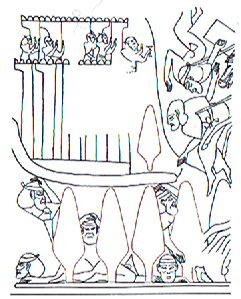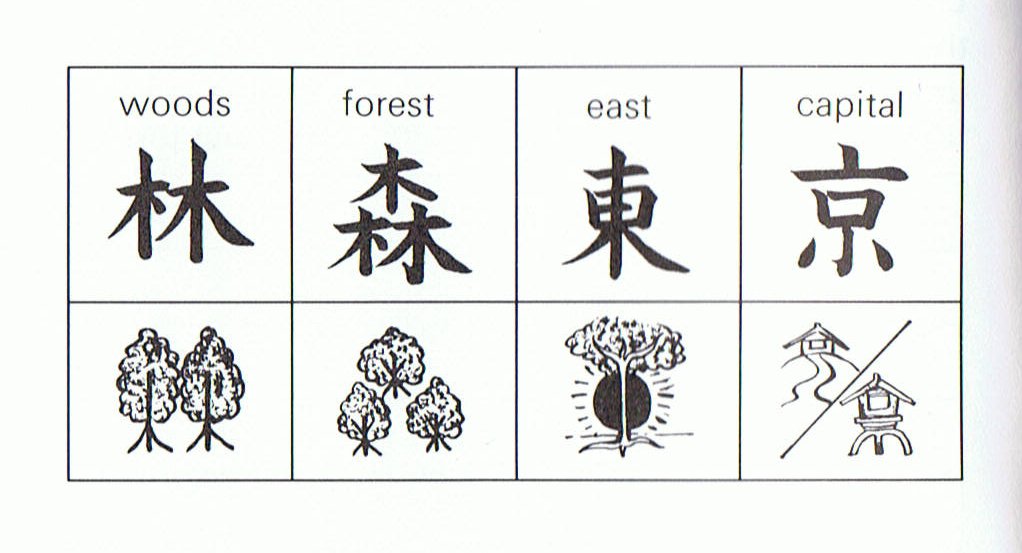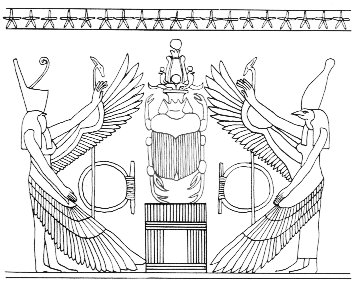|
A few preliminary
remarks and imaginations:
1. There
is a certain similarity in shape between mauga (mountain)
glyphs and the Egyptian
hieroglyph for tree
(nehet):

Trees and mountains give
shadow from
the sunlight.
Another property of trees and mountains (on which trees often
grow - in contrast to the open ploughed fields) is to be a hindrance
for watchful eyes. Trees and mountains therefore tend to be a haven
for fugitives and for people in opposition to the rulers.
In a
relief from the Amon Temple of Karnak there is a picture where the Syrian enemies of Pharaoh Seti I are hiding among
trees:

(Wilkinson) |
Top left in the picture is a curious
arrangement. The people are not up in trees,
but they look like Syrians. Maybe they are
up behind walls and defending themselves?
No, the gestures are peaceful. Are the walls
partly demolished?
Next page:
|
2.
According to a BBC produced TV progam (documented in the book
'Japanese') the glyph for 'east' (too) - as in Tookyoo
('Eastern Capital') - is derived from a picture of a tree behind
which sun is rising ( '... often explained as the sun rising
behind a tree ...'):

It is a faulty explanation. Anciently it was instead a picture of
a wooden pole (the vertical in the middle) for carrying things on,
more specifically a pole thrust through a tied sack.
Inside a tied sack, of course, it is
absolutely black.
I guess the wooden pole was once associated with the world tree and
it went right through the 'sack', i.e. the darkest time of the year
at winter solstice.
Heke is one of
words Metoro used at mauga glyphs. It means (among
other things) an octopus (8 feet).
According to Barthel 2:
'...
kahukahu o heke, an octopus hiding in his ink'.
Arriving at the last (8th) section of the cycle a dark sack is
waiting for the sun.
In the 29th night of the moon it cannot be
seen. The sun has a longer cycle, but at the end also he must
disappear for a while. |
The word 'while' looks suspiciously like
'wheel' (as in wheel of time), I think.
According to English Etymology, though,
nothing of the sort is mentioned. Instead I
find:
while ... based on
accus. of OE. hwil = OFris. hwile
... ON. hvíla bed ... cf. ON.
hvíla, hvíld
rest, repose ...
It makes sense, the sun must take a rest.
'Wheel' is the opposite of 'while', a symbol
for movement.
|
3. A
mauga glyph normally has a rhomb-like bulge, not seen in the
Egyptian nehet glyph:
The sun is not formed like a rhomb. Instead the
rhomb
probably is a picture of the earth, which has 4 sides and 4 corners.
It is not hard to imagine the proper 'map' to be like a rhomb rather
than a square - right and left are the equinoxes (east and west), at
top and bottom are the solstices (north and south):

This Egyptian picture (from Wilkinson) shows how the 4 wings
delineate a rhomb. In the middle at bottom is a door in the east
through which sun (the beetle) moves up. At left is north (shown by
the snake-like head ornament in the crown of Lower Egypt) and at
right is south (shown by the crown of Upper Egypt).
Only by
imagining looking up at the sky, lying down with feet towards east
and head towards west, does the picture agree with the cardinal
directions.
In mauga glyphs the rhomb is never drawn as if a separate
unit. Therefore mauga and earth probably are the same. The
translation of the picture becomes 'the shadow of earth'. It cannot
mean the shadow which earth casts upon the stellar person in
question. Instead it ought to mean the shadow in which earth is
lying. The stellar persons do not stop shining, it is an illusion
because we are in the shadow. |
If we are in the shadow, then there must be
some object casting this shadow. If sun is
not inside a sack, bound so he cannot move
for a while, then there must be something
between the sun and us, hiding - or at least
- diminishing his light.
For those living in India the natural
explanation must have been the Himalayas.
Mountains disturb the sight.




